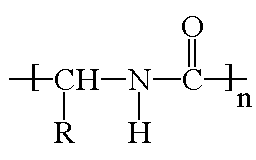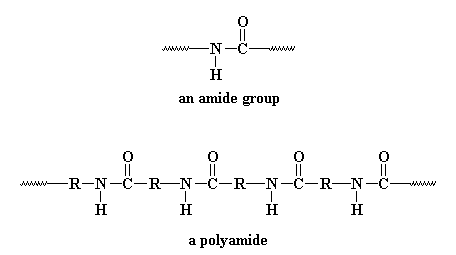
Proteins are one of many types of natural polymers, and they are the most versatile by far. You name it, proteins do it. What can proteins do? What can't they do! They can be catalysts. Some proteins, called enzymes, make certain chemical reactions in your body take place up to a million times faster than they would without enzymes. One protein called hemoglobin is found in your blood, and carries oxygen from your lungs to your cells. Another protein called collagen is a strong and tough material that makes up your skin and fingernails, and even helps to hold your internal organs in place.
So proteins are stupendously versatile. I'm convinced of that.
But would you please tell us what these things are?
A protein is a naturally occurring polyamide. That's a polymer that contains an amide group in the backbone chain. Want to see an amide group so you know just what it is I'm rambling about? Here's an amide group, and next to it is a polyamide:

That R you see in betwixt the amide groups can be anything at all, but in proteins, the R is a single carbon atom, with two pendant groups attached. One pendant is a hydrogen atom, always, and the other is a wild card. It can be a lot of different things. In this picture we just represent it as R'.

Ok, so we know what they are. But how does the body make proteins?

There are a twenty different amino acids. Want to see 'em? Click here. Each one has a different R' group. Also, each protein has a specific sequence of the different amino acids in it. So in each protein, there is a different sequence of R' groups hanging off of the backbone chain. This sequence determines the properties of the protein.
Want to know something else? Proteins also make up silk. Silk is such nifty stuff that scientists tried to make synthetic silk. They tried to make synthetic polyamides, and what do you know, they did it! The artificial polyamides are called nylons.
You want more natural polymers? Then check out these:

|
Return to Level Two Directory |

|
Return to Macrogalleria Directory |
